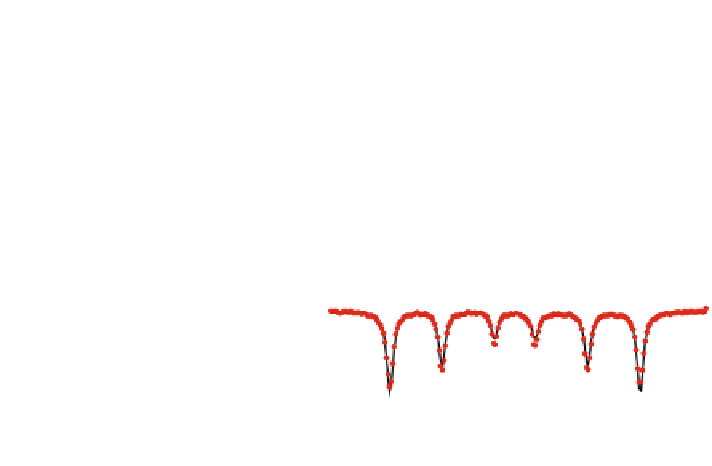Chemistry Reference
In-Depth Information
Fig. 4.19 300 K Mössbauer
spectra of the samples milled
for 16, 32, 48 and 64 h. One
notes a quadrupolar
component for 64 h milling
time attributed to wüstite-like
phase originated from
reduction effects during
milling procedure [
159
]
1.00
64h
1.00
48h
1.0
32h
1.00
16h
-8
-6
-4
-2
0
2
4
6
8
V(mm/s)
structural transformation of nanocrystalline grains into microcrystalline grains,
giving rise to more complex structured powders [
159
].
In addition to hysteresis loops, ZFC-FC magnetic measurements were per-
formed: the observed irreversibility which gradually reduces with increasing
milling time up to 48 h is consistent with the presence of grain boundaries [
159
].
One concludes from these different techniques that the as-milled nanostructured
Fe powders behave as micrometric agglomerates consisting of randomly oriented
Fe nanocrystalline pseudo-cubic grains. They are separated by a thin interfacial
layer estimated at 2-3 atomic layers where the coherent structural length is small
but the nearest neighbour surrounding of Fe atoms remains rather the same as
inside the crystalline grains, explaining their non occurrence in the Mössbauer
spectra. It can be suggested than the chemical composition of these thin interfacial
layer is the same as that inside the crystalline grain, but their topology is slightly
different: indeed, the proximity effect of neighbouring grains and strong exchange
coupling between Fe atoms from neighbouring particles do cause an apparent
increase of the coordination number of surface Fe atoms leading to the hyperfine
parameters being very similar to those of the crystalline interior. Consequently, the
Fe nanostructured powders behave as strongly correlated ferromagnets and their
magnetic behaviour is dominated by interparticle interactions [
159
].
A further insight in this ''rather simple'' nanostructure was given by a numeric
approach based on the Embedded Atom Method: this new route was developed to
model the structure of grain boundaries in metallic nanostructured powders.
Numeric aspects are detailed in [
160
]. As it is illustrated in Fig.
4.20
, realistic
atomic structures of twisted and tilted double and triple grain boundaries as a
function of the relative disorientation of the grains were successfully modelled by


































































